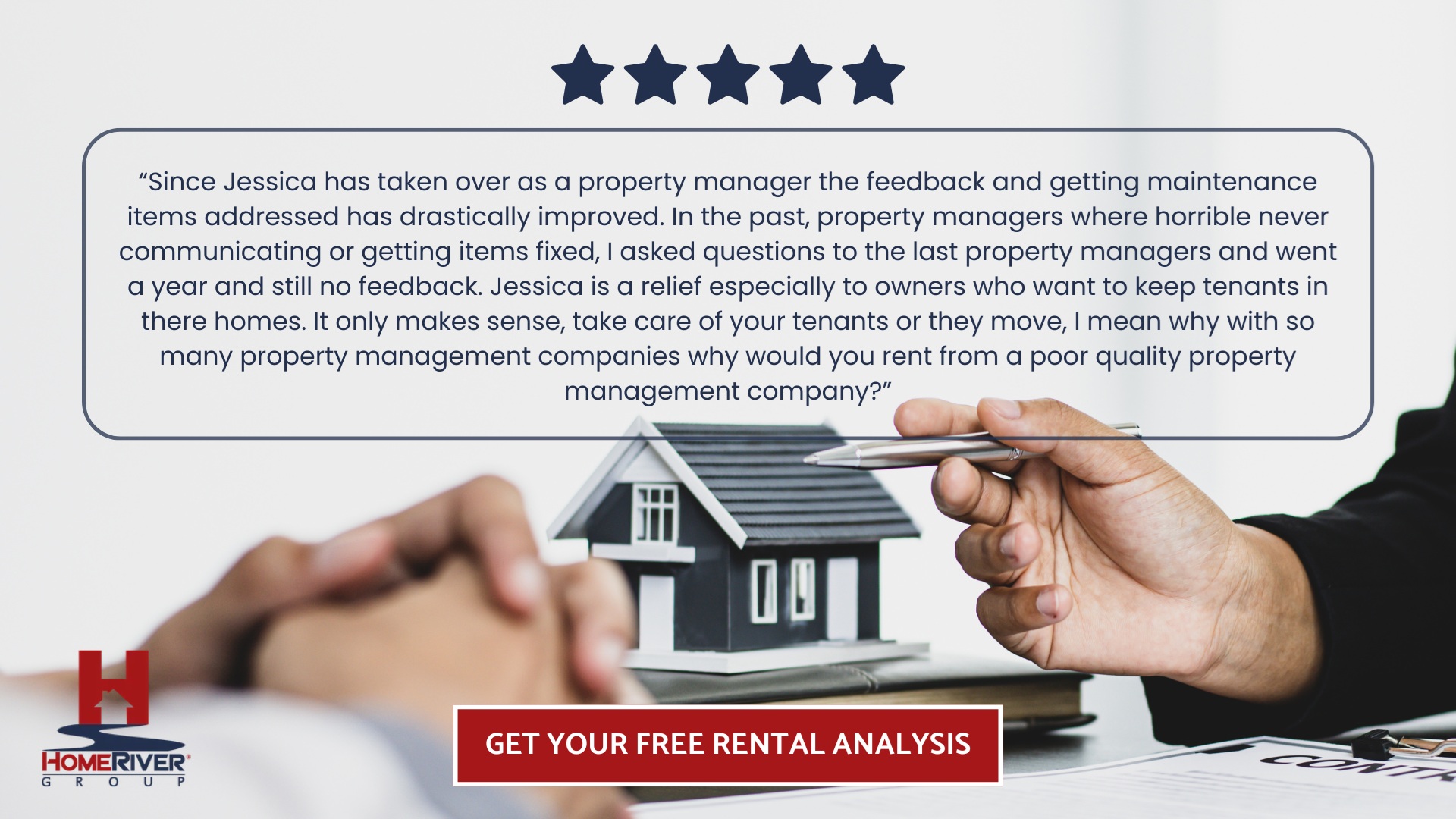
HomeRiver Group is one of the largest and most trusted residential property management companies in the U.S. With expert teams across 32+ states, we deliver consistent service, local market insight, and scalable systems that support landlords at every stage. From marketing and leasing to maintenance and compliance, we help clients minimize vacancies, maximize returns, and operate with total confidence; no matter the size of their portfolio.
A rental verification form plays a critical role in tenant screening. By confirming a prospective renter’s payment history, behavior, and lease compliance through previous landlords, this document helps protect your investment. It adds a layer of due diligence that strengthens decision-making and reduces risk. When paired with background and credit checks, rental verifications offer a more complete picture, helping you place tenants who are responsible, reliable, and likely to respect your property.
This blog will explore how to use a rental verification form effectively, what information it should include, how it fits into a thorough screening process, and why it’s essential for protecting your rental property and ensuring consistent tenant quality.
How Rental Verification Forms Enhance Tenant Screening
A rental verification form is a standardized document that landlords and property managers use to confirm a prospective tenant’s rental history. This form typically requests key information such as how long the applicant rented at a previous address, whether rent was paid on time, how the property was maintained, and whether there were any lease violations or complaints. Former landlords or property managers usually provide the details.
Going Beyond Paper Applications
When considering prospective tenants, looking beyond what’s presented on paper is essential. A rental verification form gives you an inside look at an applicant’s rental history by gathering direct feedback from previous landlords. This form typically confirms payment punctuality, property upkeep, pet ownership, lease violations, and reasons for leaving. Pairing this with thoughtful renter screening questions can further clarify potential red flags and identify strong candidates early in the process.
Identifying Patterns Of Risk Or Reliability
Using a rental verification form, you can identify patterns that may not surface during a standard credit check or background screening. For example, consistent late payments or recurring complaints reported by prior landlords can act as indicators of risk. On the other hand, positive feedback regarding a tenant’s reliability and respect for property provides added reassurance when making your decision.
Adding Objectivity Through Third-Party Input
The form also adds a layer of objectivity to your screening process. Since responses come directly from a third party, you’re not relying solely on the applicant’s self-reported information. This transparency helps mitigate the risk of misrepresentation and ensures you’re working with accurate, verifiable details.
Creating A Fair, Consistent Screening Process
Standardized verification helps keep your process uniform for every applicant. This streamlines your decision-making and supports compliance with fair housing laws, reducing the possibility of accidental bias during tenant selection. Ultimately, incorporating rental verification forms elevates the quality and consistency of your tenant screening process.
Key Elements Of A Rental Verification Form
A rental verification form serves as a critical checkpoint when screening potential tenants. Understanding the key elements included in this form helps ensure a thorough and consistent review of applicant backgrounds.
Here’s what you should look for:
This section captures basic details such as the tenant’s full name, current address, contact information, and residency dates. Accurate identification helps match the request to the correct property and applicant.
The form should include the full name, contact number, and email of the current or previous landlord or property manager. This ensures any follow-up inquiries can be directly addressed to the verified source. Including contact details is also a best practice in any well-rounded property management checklist, as it supports traceability and accountability.
Expect fields covering the lease start and end dates, monthly rent amount, and security deposit details. These points clarify the applicant's length of stay, terms of stay, and track record of financial commitment.
A rental verification form typically asks the landlord to confirm whether the rent was paid on time and in full. Any late payments, partial payments, or history of bounced checks should be documented here.
It’s common for the form to inquire about the general condition of the unit upon move-out, report damages, and address cleanliness. It may also address whether the tenant respected property rules, reported necessary repairs, and communicated well.
The form often asks whether the tenant gave proper notice before vacating and whether the move-out was amicable and as per the agreement. This section can reveal patterns of abrupt moves or unresolved disputes.
Finally, landlords are often asked if they would rent to this tenant again. This question distills the overall rental experience to a single, telling recommendation.
Reviewing these components offers a more complete, fact-based picture of whether an applicant will likely be a reliable future tenant.
Obtaining Accurate Rental Verification Information
Securing accurate rental verification information is central to effective tenant screening.
Verify The Source
To obtain reliable information, always ensure you’re contacting verified sources. Request details such as rental dates, payment history, the condition of the property when vacated, and whether the tenant adhered to the terms of their lease. These specifics help you separate truth from embellishment and allow you to spot potential red flags early. This becomes especially important when property management changes, as records may shift systems or hands, so verifying source credibility ensures continuity and accuracy in your evaluations.
Ask Targeted, Relevant Questions
Be thorough in your questions. Ask if the resident paid rent on time, whether they received notices for lease violations, and if there were any noise complaints or other issues. Uncovering details about their communication style, cooperation during inspections or repairs, and timely renewal or move-out notices can further clarify their reliability.
Cross-Check For Consistency
It’s also crucial to compare the completed rental verification form with other documentation you’ve collected, like the application and credit report. Discrepancies can be a sign that you should dig deeper. Your diligence in this process translates directly to fewer surprises down the line and a more consistent rental experience.
Legal Considerations For Rental Verification
Complying fully with federal, state, and local laws is crucial when gathering information through a rental verification form.
Comply With Fair Housing Laws: Every screening process must align with the Fair Housing Act, which protects applicants from discrimination based on race, color, religion, sex, national origin, familial status, or disability. Landlords must apply identical verification standards to every applicant. Failing to do so increases legal exposure, even unintentionally. Additionally, landlords should understand that they are not always required to give a reason for not renting, but if challenged, they must prove the decision was non-discriminatory.
Secure Written Consent: Before contacting previous landlords or employers or accessing personal information, obtain written authorization from the applicant. This is required by law in many states and ensures you’re gathering verification data legally and ethically.
Understand State-Specific Regulations: Some states have strict rules about what you can ask during tenant screening and what must remain confidential. This includes how long you can store rental verification data and what documentation needs to be shredded or digitally purged after a certain period. Ignorance of these rules can result in penalties or lawsuits.
Maintain Comprehensive Documentation: Keep a detailed record of every rental verification inquiry and response, including dates, contact names, and consent forms. Organized, well-documented files allow you to demonstrate legal compliance if a decision is ever questioned or challenged.
Observe “Ban the Box” And Local Screening Rules: Jurisdictions with “ban the box” or similar policies limit the timing of criminal or credit checks during screening. Some restrict landlords from asking certain questions until a conditional offer is made. Before structuring your rental verification form, be aware of these rules to avoid premature or prohibited inquiries.
Common Mistakes To Avoid With Rental Verification Forms
Using a rental verification form is a vital part of tenant screening, but mistakes at this stage can undermine your entire process. To ensure you’re getting the most reliable information from prospective tenants, pay close attention to these common pitfalls:
Incomplete Or Outdated Information
Submitting a form with missing details or using an outdated version weakens your screening process. Always capture the most current information—especially prior landlord and employer contacts. Incomplete forms may slow responses or reflect poorly on the applicant’s transparency. Consider pairing this with a rental property inspection checklist to cross-check any information provided about property condition at move-out.
Failing To Authenticate Responses
Take time to verify that the responses you receive actually come from past landlords or employers. Some tenants might provide contacts who are not legitimate references. When you receive a completed form, make a separate contact to confirm the details. Relying solely on what’s written leaves gaps in your due diligence.
Overlooking Privacy Compliance
Tenant information is sensitive. Make sure your process aligns with federal and state privacy laws, including the Fair Credit Reporting Act (FCRA) and any relevant local ordinances. Securely store all forms and only share details when absolutely necessary to protect tenant privacy.
Ignoring Red Flags
It’s easy to dismiss minor inconsistencies on a busy day, but small anomalies can hint at larger problems. If residence dates or payment histories don’t line up, follow up directly with references. A clear record is essential for making informed decisions.
Assuming One Size Fits All
Customization matters. A generic rental verification form may miss critical insights unique to your type of property or requirements. Adapt your forms to capture information about policies relevant to your property, such as pet ownership or smoking.
Final Thoughts
At HomeRiver Group, we recognize that finding the right tenant is one of the most critical decisions property owners make. Implementing a rental verification form is a decisive step in ensuring that tenant screening is thorough and consistent. Using a well-structured rental verification form builds a clearer picture of a prospective renter’s reliability, responsibility, and rental history.
Due diligence pays off in today’s competitive rental market. A rental verification form allows you to validate applicants' information and gives you an extra layer of assurance before handing over the keys. It streamlines your operations, minimizes risk, and increases your overall confidence in your leasing choices.
With the right tools and a partner who understands your priorities, you can make informed decisions that benefit your property, tenants, and peace of mind.
Read also:
Frequently Asked Questions About The Rental Verification Form
Why is it important to use a rental verification form?
A rental verification form is essential for property managers and landlords. It offers a standardized way to verify a prospective tenant’s rental history, payment reliability, and overall suitability. By collecting this information, you reduce the risk of renting to someone with a past of late payments, property damage, or lease violations.
What information is typically included in a rental verification form?
A rental verification form usually includes details like the applicant’s previous addresses, landlord contact information, duration of tenancy, monthly rent amount, history of on-time payments, late payments, notices to vacate, property maintenance habits, and reasons for leaving the former property.
Can a rental verification form help identify reliable tenants?
Absolutely. Verifying rental history can help you identify patterns of responsible or problematic behavior. Payment punctuality, adherence to lease terms, and respectful property use are all signs of a reliable tenant. As practiced by HomeRiver Group, a standardized rental verification process filters out high-risk applicants and surfaces those who fit your property needs.
What are the consequences of not using a rental verification form?
Skipping this step can lead to renting to unreliable tenants, resulting in late rent payments, property damage, and potential eviction proceedings. Without formal verification, you lack critical insight into an applicant’s rental behavior and may face unnecessary financial and legal challenges.
How often should a landlord update a rental verification form?
Review and update your rental verification form regularly to ensure it aligns with current regulations and best practices. We recommend revisiting the form annually or whenever significant changes in local or federal housing laws exist. This keeps your screening process effective and compliant.
How does a rental verification form assist in screening tenants?
A rental verification form is the first line of defense in the tenant screening process. By following a standardized template, you gather the exact key details for every applicant, making it easier to compare candidates and spot discrepancies or red flags.











